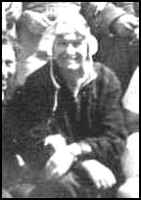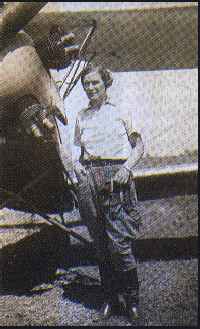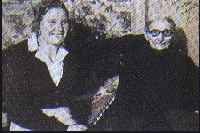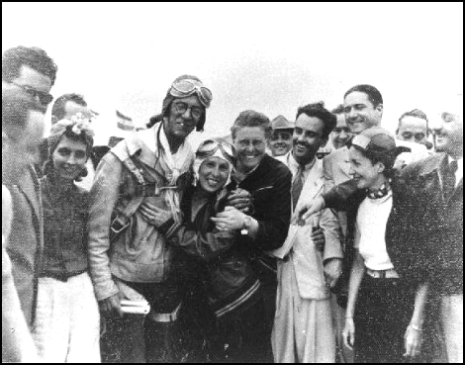
Carola, 1938

Carola and Focke-Wulf
Collection of Angel Martini

Carola & Mother
 Carola, 1938 |
 Carola and Focke-Wulf Collection of Angel Martini |
 Carola & Mother |
Cortesia de Guillermo García, 4-18-07 Su padre se ganaba la vida como zapatero Gran deportista practico equitacion, remo, atletismo, salto, pelota, remo, jabalina y hockey. 1925 fue campeona de atletismo Fue la primera mujer que manejó un auto en su pueblo. Trabajó como dactilógrafa 1931 la aceptaron en el Aero Club Argentino de Morón, el curso de instrucción le acabó sus ahorros, además de tener que vender su bicicleta y un diccionario enciclopédico 4/11/1933 recibió el carnet de piloto de aviador civil internacional nº 436 Fue la primera mujer que obtuvo el título de instructor de vuelo en América del Sur Luego, se dejó cautivar por la alta acrobacia: aquellas piruetas que daba en el aire quien sería su maestro y compañero de dúo, Santiago Germano. Juntos dieron espectáculos en la Argentina y participaron de competencias en Uruguay y Brasil. Utilizaba para sus vuelos de acrobacia un Focke Wulf FW44 Stieglitz 31/3/1935 record sudamericanao femenino de altura con 5381 metros al mando de un avión de producción nacional Ae C3 (el tercer aparato para uso civil producido en el país) 13/11/1935 fue la primera mujer en cruzar sola el Río de la Plata con su avión Fleet 51, pese a que falló el altímetro, Carola tuvo que apelar a su intuición para sortear la bruma que había en los terrenos cercanos a Carmelo, donde aterriz 1941 logro su licencia para servicio publico comercial Con motivo de la visita de la escuadrilla femenina del centro aeronautico del Uruguay hizo un vuelo demostrativo en honor de los visitantes, Eran alrededor de las 16 horas de ese domingo, cuando se elevó en un Focke-Wulf recién preparado (que no era el que tenía asignado), hizo unas pocas maniobras acrobáticas y al entrar en un looping invertido del cual no pudo salir, la máquina fue a caer detrás de los hangares en el aeródromo de Moron, provincia de Buenos Aires Carola adoraba la tierra y el cielo de su país. Era muy amiga de las cosas criollas: donde iba y encontraba algo autóctono lo traía. Su dormitorio era un lugar ornamentado de manera muy original: mantas indias, arcos, flechas, boleadoras, espuelas y tantas otras cosas propias del hombre de campo. Además, solía vestir bombachas criollas, botas y campera de cuero. Esta pasión por las tradiciones rurales e indígenas argentinas le mereció el apodo por parte del periodismo de "la aviadora gaucha" |
Courtesy of Guillermo García, 4-18-07 Her father earned his living as a shoemaker. An avid sportswoman, she practiced equitation, athletics, salto, ball, remo, jabalina and hockey. In 1925 she was a champion athlete She was the first woman to drive a car in her town. She worked as a typist. In 1931, they accepted her into the Aero Argentine Club of Morón, the training course exhausted her savings, forcing her to sell her bicycle and an encyclopedia On November 4, 1933, she received her pilot's license, number 436, designating her as an international civil aviator. She was the first woman to obtain the title of flying instructor in South America Soon, she became captivated by acrobatics: those pirouetes performed in the air that would be both her teacher and companion. Teemed with Santiago Germano, they presented spectacles in Argentina and participated in competitions in Uruguay and Brasil. They used a Focke Wulf FW44 Stieglitz for their aerobatic displays. On March 31, 1935, she set a record for altitude in South America for a woman, reaching a height of 5,381 meters at the controls of national production Ae C3, (third apparatus for civil use produced in the country). On November 13, 1935, she was the first woman to cross singlehanded the Río de la Plata in her Fleet 51 airplane. Because the altimeter failed, Carola had to depend on her intuition to penetrate the mist that was over the land near Carmelo, where she landed. In 1941, she earned her commercial license. On the occasion of a visit of the feminine squadron of the Uruguayan aeronautical center, she made a demonstration flight to honor the visitors, About four in the afternoon on that Sunday, when she rose in a Focke-Wulf just prepared (that was not the one that it had assigned), made few maneuvers acrobatic and when entering looping inverted of which it could not leave, the machine went to fall behind the hangars in the aerodrome of Moron, province of Buenos Aires Carola adored the land and the sky of her country. She was very fond of Creole things: wherever she went and found something native, she brought it. Her dormitory was ornamented in a very original way: Indian blankets, bows, arrows, boleadoras, spurs and many other things related to the native man. In addition, she used to dress Creole, dull baggy trousers and leather boots. This passion for the rural traditions and the indigenous Argentineans inspired her nickname in the media of "the aviatrix gaucha." |
|
Carolina Elena Lorenzini Argentine aviatrix "She was born August 15, 1899 in the then Quarter 8, subsequently known as San Vicente and today as the city of Alexander Korn, province of Buenos Aires. She was seventh of eight children, her parents being Jose Lorenzini and Luisa Piana. She was the first woman to earn the title of flying instructor in South America. She became fond of sports and took part in jumping, ball, rowing, javelin, and hockey. In 1925 she was a champion athlete. She was the first woman to drive a car in her town. She worked as a typist. In 1933 she began a course of instruction in the Aeroclub of Motón, which exhausted her savings, including having to have to sell her bicycle and an encyclopedic dictionary. She earned the International Civil Aviator license No. 436. On March 31, 1935, she attained a height of 5381 meters. (about 17,654 feet). She wanted to be the first woman to cross singlehanded the Rio de la Plata in her airplane, which didn't have a compass, which she did on November 13, in her airplane "Fleet 51," . Carola had to depend on her intuition to descend through the mist that covered the land near Carmello where she landed. She won various races regularly and she then enrolled in a course of advanced acrobatics. |
 |
|
Photo from the Anésia Pinheiro Machado website Courtesy of Alex Pinheiro Machado Rodrigues |
| On the afternoon of November 23, 1941, while doing an acrobatic maeuver, she lost control of the machine and crashed against the Earth. Her tragic death could not be avoided, but her wish that she not die in a fire, which she had expressed so many times, was fullfilled, The dramatic crash took place in Morón, the day she was making an exhibition of acrobatics in honor of a delegation of Uruguayan aviatrices. It was around 4 p.m. Sunday afternoon when she went up in a Focke-Wulf which had just been made ready, (that was not the one that she had been assigned), did few acrobatic meneuvers and upon entering an inverted loop, was not able to recover, the plane falling to the earth behind the hangars. She is buried in San Vicente." |
|
by Laura Isola This is the most interesting and complete story of her life and career which I have found so far. If you can read Spanish, you can access the article by clicking on the title above. If you need an English translation, translated by machine, click on the title below. I am sorry I can't offer a better translation of the article, but at least you can get a sense of the story. |


|